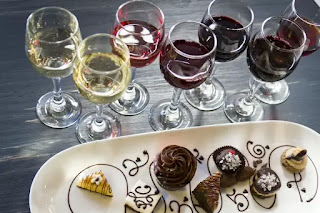It's science, of course, and most of us don't really know how it works. It helps if you realize your perception of a wine can be altered by many things, including being sick, even who you are with, and palate fatigue (already had too much wine and your senses are tired or it all). Food definitely has a big effect on a wine's taste. If done right, the food and wine will both be altered in a good way.
 |
| image from tasteofhome.com / getty |
We look at some basic elements in food and wine: acidity, tannins, saltiness, and sweetness.
Acidity in Foods and in Wines
Acid in wine may make a wine seem clean, refreshing, or bitter. Foods with high acidity, like citrus or
tomatoes, can make a wine taste milder and less acidic. Conversely,
wines with higher acidity can cut through the richness of fatty or oily
dishes, providing a refreshing contrast.
Example of Wine with Higher Acidity Cutting Through Rich Foods
- Wine: Sauvignon Blanc
- Food Pairing: Salmon with a butter sauce
- Explanation: The high acidity in Sauvignon Blanc helps cut through the richness of the buttery sauce and fatty salmon, refreshing the palate between bites.
Foods with High Acidity Mellowing a Wine's Acidity
- Wine: Chardonnay
- Food Pairing: Caprese salad with ripe tomatoes, fresh mozzarella, and basil
- Explanation: The acidity in the tomatoes of the Caprese salad can make the Chardonnay taste smoother and less acidic. The wine's fruitiness complements the ripe tomatoes, while its acidity is balanced by the acidity in the dish.
Tannins in Wine
Tannins can make a wine seem dry and astringent. You might taste bitterness. They also provide structure to the wine and provide aging potential. Over time, tannins dissipate, but if you don't want to wait, you can pair a tannic wine with a fatty or protein-rich food. Cabernet Sauvignon is an example of a tannic wine. This is why the classic pairing is steak with Cab. Other high tannin wines are Syrah and Nebbiolo.
- Wine: A young Cabernet
- Food: Rib-eye steak
- Explanation: The tannin molecules in the wine bind themselves to the proteins in the meat. The wine is improved, the steak is improved, and you are aware of the more subtle flavors of each.
Saltiness in Food
Salt can enhance fruit flavor in wine and decrease bitterness. Sparkling wine or a crisp white work well with salty foods. Examples of crisp white wines would be most Sauvignon Blanc, Riesling, and Vermentino.
Savory / Umami in Food
Umami is described as brothy, meaty, or even MSG. This means the food doesn't belong in one of the four basic tastes of sweet, sour, bitter, and salty. Think of mushrooms, aged cheese, or quiche. These foods can make a wine taste more tannic so a white wine or a Pinot Noir is usually best.
Sweetness in Food
Sweetness can mask tannins and acids. This is why you see many cheap red wines that are somewhat sweet.
Sweet foods can make a wine taste more
bitter and less sweet. Therefore, a wine paired with a sweet dish should
ideally be as sweet or sweeter than the food to maintain balance. Riesling and Sauternes are the classic sweet wines. They pair with various sweet or spicy dishes, fruity desserts, and aged cheeses, with Riesling and Blue Cheese being a classic pairing.
 |
| image from lovetoknow.com / getty |
Source: Information taken in part from Scott Harvey Wines and GuildSomm.com
No comments:
Post a Comment